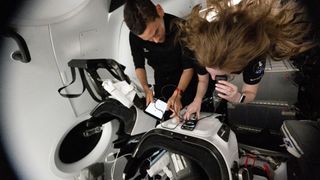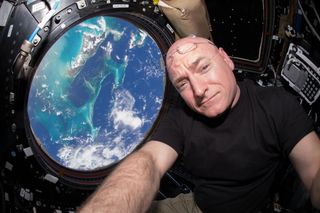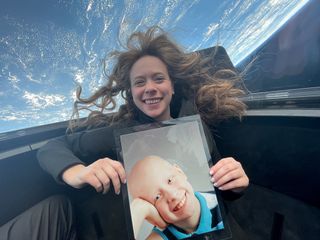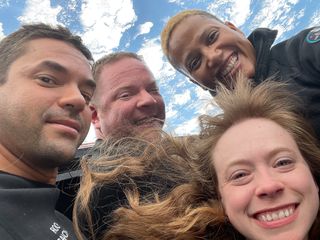SpaceX's Inspiration4 astronauts got genetically younger in space: study
"We are getting closer to the point where we can almost measure the dose of space on the body."

The four crew members of Inspiration4, the first ever all-civilian space mission, got genetically younger during their stay in space, a study has found. But the effects didn't last long. Scientists are now trying to unravel how the space environment affects human DNA.
Inspiration4 crew members had a packed schedule during their three-day trip to space in September 2021. Instead of just floating around in weightlessness and enjoying the breathtaking views from their modified Crew Dragon Resilience space capsule, they lent their bodies to science.
Hayley Arceneaux, the mission's the chief medical officer and trained physician assistant, was busy during their time orbit taking fingerpick blood samples and skin swabs of herself and her crewmates. A battery of tests followed their return to Earth and continued for several months after that.
Results of these experiments have been published in three scientific papers in the journals Nature and Nature Communications on Tuesday, June 11. The tests showed that the space environment has fast-acting and profound effects on the human body, which can be detected in markers in blood after only a few hours in orbit.
NASA, JAXA and the European Space Agency have previously conducted similar experiments with astronauts during long-duration stays on the International Space Station, but the Inspiration4 mission provided scientists with an opportunity to study the earliest stages of these space-induced processes in the human body.
Related: Inspiration4: The first all-civilian spaceflight on SpaceX Dragon
Chromosome caps getting longer
"We are getting closer to the point where we can almost measure the dose of space on the body," Chris Mason, a professor of genomics, physiology and biophysics at Weill Cornell Medicine and Scientific Advisory Board member at biotechnology company Seer whose Proteograph was used to analyze the data, told Space.com in an interview. "They were in space only for a few days, but we could already see early signatures of spaceflight exposure on the body including protein changes and gene expression changes."
Get the Space.com Newsletter
Breaking space news, the latest updates on rocket launches, skywatching events and more!
For example, the researchers observed that markers indicating the aging of DNA decreased in space, making the crewmembers' DNA appear younger and healthier. Those markers, known as telomeres, are caps that protect chromosomes that are known to shorten with age and due to environmental factors and stress.
For the Inspiration4 participants, however, the telomeres got longer during the space mission. Scientists previously observed telomere lengthening in NASA astronaut Scott Kelly when they studied the effects of his one-year stay in orbit in 2015 on his body. The findings were already surprising back then as the researchers expected the opposite to happen due to the high levels of stress the organism is subject to in space.

To see those effects in the Inspiration4 crew members after only a few days in space was even more unexpected, scientists say.
"We did see telomere elongation in all four of the crew members," Susan Bailey, a professor of radiation cancer biology and oncology at Colorado State University who led the research, said in a press conference presenting the papers on Monday, June 10. "It's really a remarkable finding in a number of ways and helps us solidify our findings."
The researchers think the telomere elongation is triggered as a protective response by exposure to the higher radiation environment of space. Similar effects have been measured in mountain climbers after they scaled the world's highest peaks.
"We think it's the DNA's equivalent to hormesis," Mason, lead author of two of the studies, said. "It's the effect that we see when you stress the body, for example in the gym, your muscles get sore, but the body responds by building strength."
There is, however, a catch, said Bailey. After the astronauts' return to Earth, the telomeres shrink almost immediately and get shorter than they were before the spaceflight. The researchers, Bailey said, don't understand what triggers the shortening but hope they might be able to control the response in the future.
"It takes a number of months for the telomeres to recover," Bailey said. "It's one of the things that doesn't quite get back to where you were when you started. We think that there is a real opportunity to think about long-term health outcomes for astronauts once they return to Earth and how we can better monitor and improve that outcome."
The shortening of the protective telomeres leads to DNA damage and makes individuals susceptible to a range of diseases including cancer, heart disease or immune system deficiency. Research, however, suggests that healthy diets and restorative practices such as meditation can help those chromosomal caps to recover.
Just like in astronauts in long duration mission, the bodies of Inspiration4 crew members showed other signs of aging during the spaceflight including increased markers for bone and muscle loss and brain stress. Those, however, returned to pre-flight levels within six months. Inspiration4 crew members Hayley Arceneaux and Chris Sembroski, who participated in the briefing didn't seem to regret the degradation their telomeres suffered due to their space trip.
"I was so happy to be able to contribute to science and I know that it was very important for all of our crew members," said Arceneaux.

Sembroski added: "It's really humbling and honoring to be a part of this study. I don't think any of our crew members really understood the full potential of what this mission was going to turn into, but it's been incredible to see the impacts that have come from it."
The study also found that the female crew members Arceneaux and geologist Sian Proctor recovered faster from the spaceflight with most of their health markers back at pre-flight levels faster than those of their male counterparts Sembroski and mission commander and benefactor Jared Isaacman. The results confirm observations in female NASA astronauts and suggest that female bodies may be better suited to endure the stresses of spaceflight.

The data will be part of an open-access astronaut biological data repository, the Space Omics and Medical Atlas (SOMA), which has also been published as part of the Nature package. The atlas contains data from long-duration space missions conducted by NASA, JAXA and ESA, and it's a first-of-a-kind resource allowing researchers to compare and study in detail the many biological, physiological and genetic changes that can occur in humans during spaceflight.
The researchers hope the database will enable them in the future to not only select people that are genetically best suited to endure the rigors of space travel, but also to devise strategies to improve the outcomes for those suited less.
"We want to use this data to predict how people will respond to space at a physiological and molecular level," said Mason. "Eventually, we would like to find ways to boost their response, target some of the changes with a drug and help them, so that we don't exclude anybody from going to space."
Mason, in fact, published a book in 2021 called "The Next 500 Years: Engineering Life to Reach New Worlds," in which he makes a case for genetically engineering humans to make them better suited to explore and settle the solar system. He admits that the current state of knowledge is not sufficient to attempt any tempering with astronauts' genomes.
"We need probably another 20 years of data before I would even think we could have a good guess as to what to do," said Mason. "But this is the beginning of mapping out what changes to target, what to build new drugs around and what someday we can potentially do."
The research could also help medical scientists on Earth looking to find cures for genetic ailments that ruin lives of millions of children worldwide and for which there is currently no remedy.
The three studies in the journal Nature about these spaceflight-induced genetic changes crew can be found here, here and here.
Join our Space Forums to keep talking space on the latest missions, night sky and more! And if you have a news tip, correction or comment, let us know at: community@space.com.

Tereza is a London-based science and technology journalist, aspiring fiction writer and amateur gymnast. Originally from Prague, the Czech Republic, she spent the first seven years of her career working as a reporter, script-writer and presenter for various TV programmes of the Czech Public Service Television. She later took a career break to pursue further education and added a Master's in Science from the International Space University, France, to her Bachelor's in Journalism and Master's in Cultural Anthropology from Prague's Charles University. She worked as a reporter at the Engineering and Technology magazine, freelanced for a range of publications including Live Science, Space.com, Professional Engineering, Via Satellite and Space News and served as a maternity cover science editor at the European Space Agency.
-
newtons_laws The article said "For example, the researchers observed that markers indicating the aging of DNA decreased in space, making the crewmembers' DNA appear younger and healthier. Those markers, known as telomeres, are caps that protect chromosomes that are known to shorten with age and due to environmental factors and stress.Reply
"We did see telomere elongation in all four of the crew members," Susan Bailey, a professor of radiation cancer biology and oncology at Colorado State University who led the research, said in a press conference presenting the papers on Monday, June 10. "It's really a remarkable finding in a number of ways and helps us solidify our findings."
The researchers think the telomere elongation is triggered as a protective response by exposure to the higher radiation environment of space. Similar effects have been measured in mountain climbers after they scaled the world's highest peaks. "
Well if the telerome elongation is caused by exposure to a higher radiation environment then this hypothesis could presumably be easily checked by looking at the teleromes of the thousands of classified radiation workers who receive higher radiation doses than the general population. That is a large statistical sample which would be expected to show such an effect if the hypothesis is correct. -
Unclear Engineer This "lengthening of telomeres" effect was measured only in blood samples? If so, then maybe it is not a lengthening of telomeres in the bone marrow cells that produce the blood cells, but instead an increase in the preservation of telomere length in the cells produced, instead of a reduction occurring in the process. So, perhaps the produced blood cells have longer telomeres when produced in space, compared to those produced on Earth, but the stem cells themselves do not have increased telomere lengths. That would help explain why the effect vanishes so quickly when the astronauts return to Earth, and also why the final result is still a reduction in the telomere length in blood cells. The stem cell telomere lengths might be getting reduced at the normal on-Earth rate or even faster while in space, but the product blood cells generation with enhanced telomere reproduction could swamp that effect on result based only on blood samples.Reply
Just at thought, but one that I think needs to be addressed before jumping to conclusions about effects on cells that were not measured directly. -
danR "...fingerpick blood samples..."Reply
*fingerprick
They didn't collect the blood samples by playing the banjo 🪕 .
:)